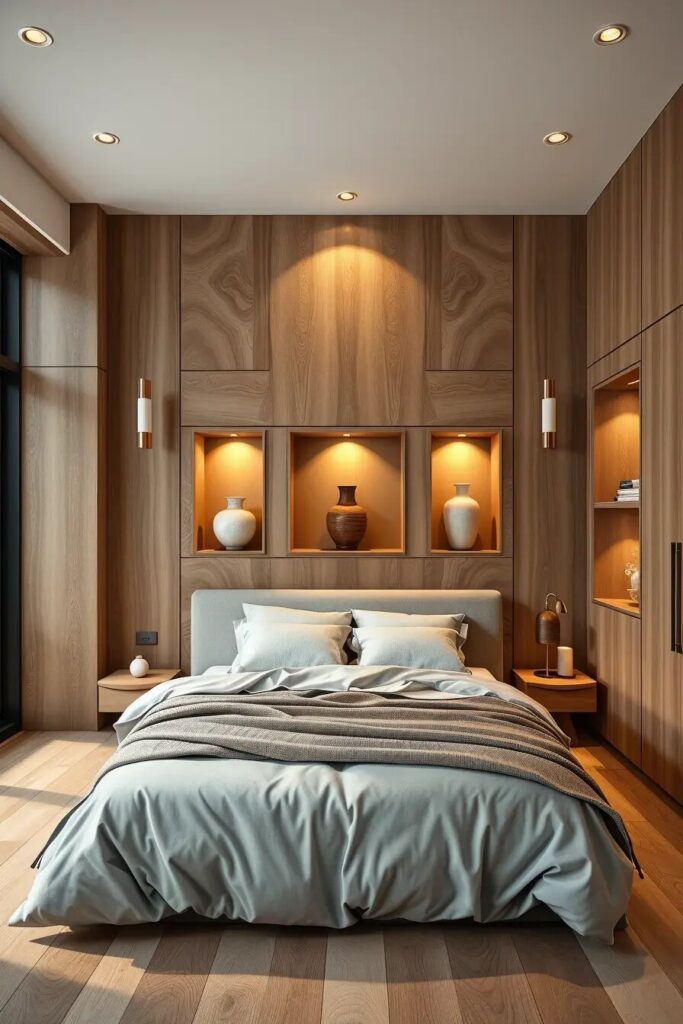Have you ever thought about how to create a peaceful and efficient vibe in your bedroom? A lot of folks are really digging the Japandi-style bedrooms because they look so neat and cozy. And it’s not just about how they look – they also bring a sense of calm to the room. I’ll show you some cool Japandi-style bedroom ideas that combine the simplicity of Scandinavian design with the elegance of Japanese aesthetics. In this guide, you’ll find clean lines and soothing textures to help you create your perfect Japandi home.
Embrace Cozy Japandi Style for a Minimalist Home
When I create a Japandi-style bedroom, I focus on keeping it simple and cozy. The key to minimalist design is finding balance by removing unnecessary clutter and incorporating soft textures and natural materials. In a Japandi bedroom, you’ll find spacious layouts, calming neutral tones, and only a few well-chosen furniture pieces to promote a sense of tranquility and clarity. Having fewer items isn’t just about style, it also helps keep things tidy and gives a sense of calm to the room.

In my bedroom, I’ve kept it simple with just a cozy wooden bed, a cute bench, and a couple of beautiful side tables. I love adding warm LED lights that give the room a soft glow and create a cozy atmosphere. I also like to throw in some textured rugs or tatami mats to add a touch of comfort. I’ve carefully selected each piece to create a Japandi-style vibe, which is all about being both functional and peaceful.

In my opinion, when you prioritize quality starting with the basics, it makes the room feel more spacious and inviting. It helps counteract the overwhelm of clutter culture. I really like Bobby Berk’s suggestion of investing in fewer but higher quality items, it really complements this approach. The end result? A space that feels clean, well-organized and welcoming to everyone.
If you’re looking to spruce up your space and make it feel more cozy, consider adding a neutral-toned accent chair or a cool sculptural stool that’s made from natural materials. This little corner can do double duty as a stylish addition to your room and a cozy spot for meditation or curling up with a good book. So go ahead and create a cozy corner that’s just perfect for you!
Discover the calm beauty of nature-inspired neutral color schemes
In a Japandi bedroom, you won’t find any bright or bold colors – they’re all about creating a peaceful vibe. Personally, I love sticking to warm beige, taupe, muted gray, and soft whites. These colors really help to keep the room feeling calm and cozy, while also allowing natural light to filter in without any harsh glares. When these hues are mixed just right, it really brings that serene Japanese interior or hygge feel that you see in Scandinavian homes.

You know, you can keep the walls nice and light, but why not have a bit of fun with the bedding and textiles by throwing in some darker taupe or charcoal colors? And how about some pale oak or smoked ash timber floors to really tie the room together? Oh, and don’t forget about adding in some handmade ceramic vases or textured fabric cushions to give it that extra touch of personality! This whole color scheme is all about staying classic and timeless, so you don’t have to worry about it going out of style anytime soon. It’s all about creating a space that will never go out of fashion.

I’ve heard that neutral colors in bedrooms are a good choice because they last over time. I followed someone’s suggestion to mix in different shades, instead of just sticking to one color, and I really love how it turned out. The room feels more alive and vibrant without feeling too busy or cluttered.
Have you ever noticed how a room can feel unbalanced if it’s missing a matte texture? You can easily enhance the overall feel of a space by adding in elements like a linen drape, a cozy boucle throw, or a stylish clay lamp. These not only look great, but they also add a nice tactile element to the room.
Sleek & Modern: Low Beds for a Contemporary Bedroom
In a Japandi-style bedroom, you’ll often find a cozy low platform bed. It really sets a calming vibe and makes you feel more grounded while also making the room feel more spacious. Personally, I always recommend frames made from natural woods like oak or walnut. I like ones with simple square edges that maybe have a slight curve for a softer look. Just adds a touch of warmth and elegance to the space in my opinion.

When setting up my bedroom, I like to keep things simple and cozy. I usually have a bed with no handles on the nightstand, a round hanging lamp, and maybe a cushion or pouf for a Japanese touch. I prefer a medium-firm mattress topped with neutral-colored bedding made of breathable fabrics. This mix of Scandinavian coziness and Japanese minimalism really creates a calming atmosphere in the room.
You know, I’ve discovered that switching to a low platform bed in a room can really bring a sense of peace and quiet. I’ve even noticed interior designers, like Athena Calderone, suggest these types of beds to really tie a bedroom design together. It’s a simple concept, but it definitely does the trick!
I think it would be really nice to add a headboard made of woven or slatted wood to the bed. It could help to give the room some texture and make it look really nice without making it feel too crowded.
Add a Touch of Nature with Earthy Tones and Wooden Accents
I love adding earthy colors like clay, terracotta, sand, and moss to my bedroom – it really gives it that cozy Japandi vibe! The way these colors complement the wood in the room makes everything feel so warm and balanced. I think incorporating earthy tones into your home is a great way to bring a little bit of the outside world inside, which totally fits with the whole Japandi idea of staying connected to nature.

So, when I’m working on these notes, I like to start by throwing in some beams, window trims, or exposed wooden shelves. Adding cedar or pine really gives it a Japanese vibe, while walnut brings in a touch of Scandinavia. To finish off the look, I like to throw in some ceramic or stone vases, handwoven baskets, and some linen in russet and olive shades. It really brings the whole design together, don’t you think?

Architectural Digest actually suggests avoiding overly polished finishes. They’re really into this Japandi style right now, which is all about embracing imperfections and uniqueness. Personally, I love going for wood that shows off its grain, knots, and little quirks. It just adds a cozy and stylish touch to a space without looking cluttered.
How about adding some wall art in rust colors or some cool handmade wooden pieces to really bring out the natural vibes in this space? It’ll make it feel extra special and cozy!
Cozy Layers: Luxurious Linen Bedding for Ultimate Comfort
I love how the bedding in a Japandi bedroom perfectly combines style and comfort. Linen is my top choice because it’s breathable, looks effortlessly chic even when wrinkled, and gets cozier with every wash. When making my bed, I like to use warm gray, bone white, or flax linens, and I always add cotton or wool throws to add some texture and ensure it’s cozy for whatever season it is. It’s all about creating a space that not only looks great but also feels inviting and relaxed.
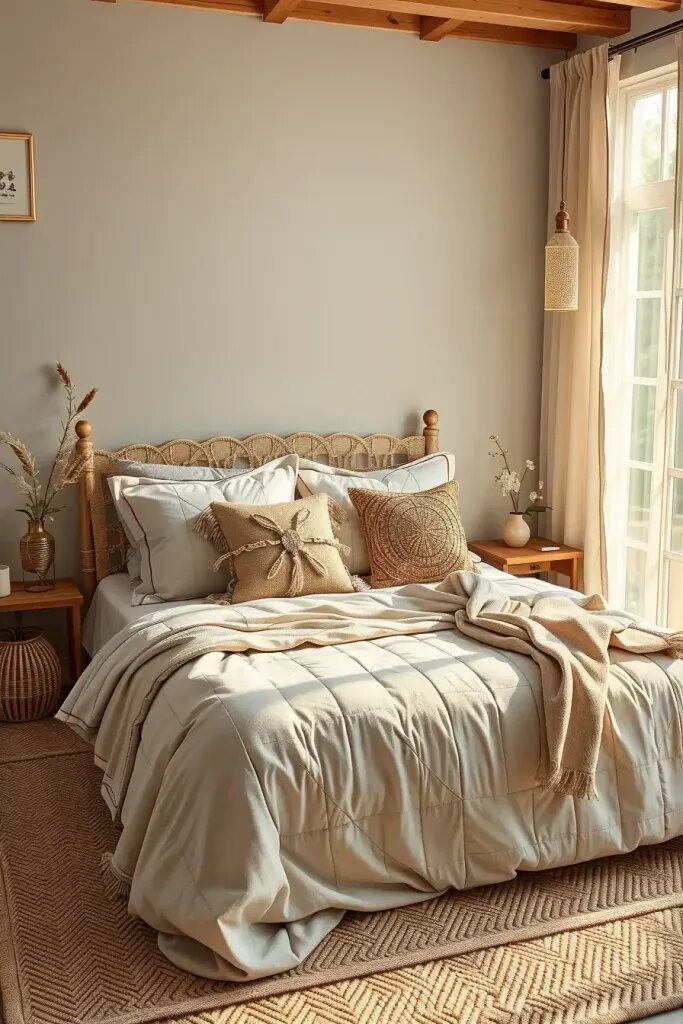
When setting up your bed, think about the practical elements you really need for a cozy setup. I like to use a linen duvet cover as the base, with a light blanket and a nice textured throw at the end for extra warmth. For pillows, I prefer hemp or bamboo for a more natural feel that doesn’t overwhelm the room. I like to keep the overall look simple and understated with minimal patterns to create a calming vibe.
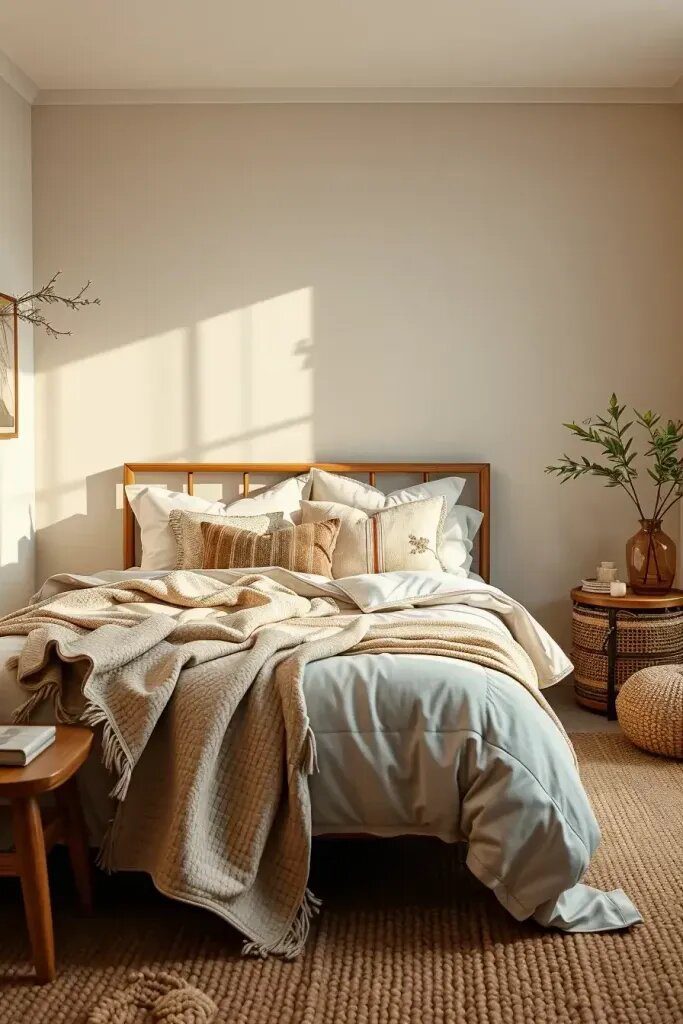
For me, there’s just something about sleeping in linen that feels so cozy and cooling. It gets softer and better with every wash, which I love. I totally get what designers like Sarah Sherman Samuel talk about when they mention how the texture of bedding can really elevate the overall design of a room. Isn’t it so true?
Here’s another idea for you – how about adding a nice area rug under the bed to tie everything together and complete the look of your room?
Illuminate your Japandi Oasis with Stunning Sculptural Lights
When it comes to lighting in a Japandi-style bedroom, you’ll want to go for something that’s not only unique but also soft and thoughtfully placed. I personally love using materials like paper, rice paper, linen, or ceramic for my lampshades because they give off a nice, diffused light. The goal here is to showcase the beauty and functionality of the room in a clean and simple way.

I love having a chandelier above my low nightstand or a cozy floor lamp in my reading corner. I recently switched to using wooden or matte black wall sconces and it has really added a nice touch to my space. The warm white LED bulbs I use give off such a calming glow in the evening. It’s amazing how much lighting can really change the atmosphere of a room. Have you noticed the difference good lighting can make?

So, for one of my Japandi projects, I decided to go with a Noguchi-style lantern as the main light source. It turned out to be subtle yet super attractive. I remember hearing designer Nate Berkus talk about how sculptural lights can double up as pieces of art, and I totally see what he means when I look at these photos.
How about adding a lamp with some unique or organic shapes to help create a nice balance and draw the eye in the room?
Clean Aesthetic With Smart Storage Ideas
I always make sure to find clever storage solutions to keep my Japandi space looking calm and tidy. I like using under-bed drawers, sleek wardrobes, and hidden storage areas to help minimize clutter. It’s important to maintain the simple and clean aesthetic while still keeping things organized.
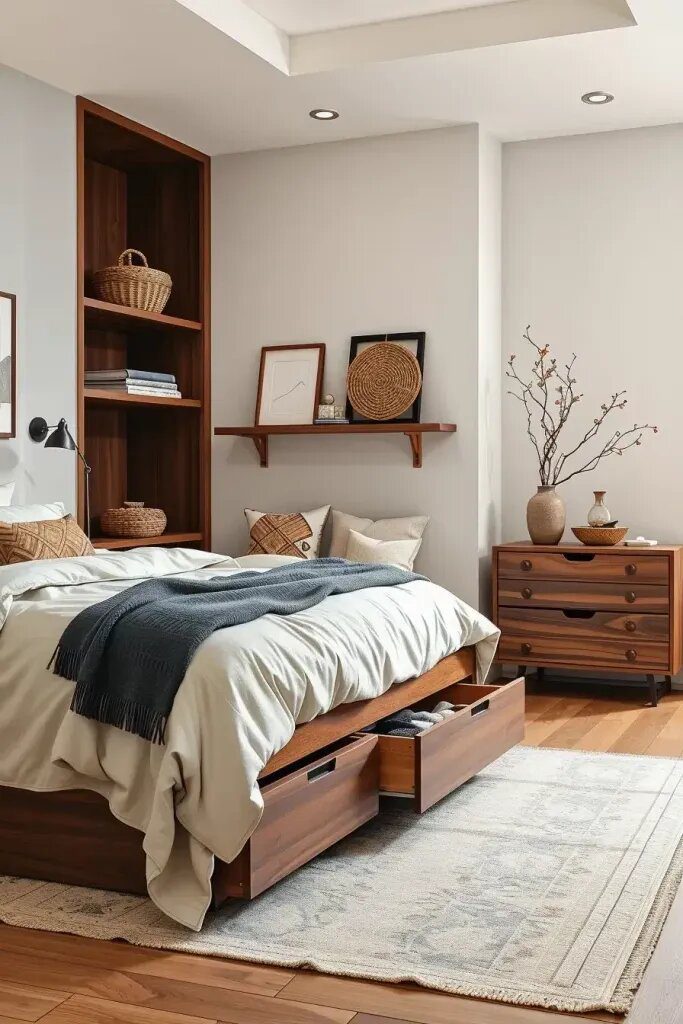
I love furniture that has a simple and elegant look, like a matte dresser or low storage benches. Drawers without handles that appear to float are also a favorite of mine. Seagrass and rattan baskets are perfect for storing items in a stylish way. And custom sliding panels in closets are a great way to keep the space looking nice without adding unnecessary bulk to the walls.

I’ve noticed that keeping the shelves in a neutral color makes it easier for folded linens or books to blend in nicely, especially if you don’t have too many of them. You can really see Marie Kondo’s idea of “everything having its place” reflected in the Japandi style. The goal is for the room to feel peaceful and serene once someone walks out of it.
You could also consider adding a slim console table or a narrow shelf near the entrance. It’s a handy spot to place things without disrupting the calm vibe of the space.
Discover the Comfort of Zen Corners with Tatami-Inspired Rugs
I always make sure to have a little Zen corner in my bedroom, following the Japandi style. It’s a dedicated space for me to have some quiet time and relax whenever I need to. I love putting down a tatami-style rug in this corner because it brings a touch of Japan to the room and makes the floor feel extra cozy. It helps to create a calming atmosphere without overpowering the rest of the room.

I love to create a cozy corner in my home by using a rug or mat that complements the tight weave of tatami. I keep it simple with a comfy floor pillow, a low table, and a ceramic incense holder. Everything I choose to add to the space has to bring some real value to the overall vibe. Sometimes I’ll hang a decorative curtain to separate the area and place a tall plant in a plain planter to bring a calming presence to the corner. It’s all about creating a space that feels meaningful and relaxing.

I’ve noticed that when I decorate my space with things that help me relax, like cozy tatami mats, it really adds a peaceful vibe to the room. It’s funny how small details like that can have a big impact on the atmosphere, especially when I’m working on my music.
You know what would really enhance this area? Adding a paper lantern or some cool sculptural lighting! It’ll give off a soft, gentle light that really makes the Zen corner stand out without being too bright.
“Experience the Beauty of Nature in Every Element”
I absolutely love creating Japandi bedrooms because they have such a special vibe! The key is using simple, natural materials like wood, stone, bamboo, linen, wool, and clay for everything from big furniture pieces to small decor items. These materials not only add a peaceful feel to the room, but they also help to enhance the overall ambiance. It’s all about bringing that calming and cozy vibe to life!

Personally, I love adding a sturdy bed frame, a rustic wooden bench, and some pebble-finish ceramic pieces to my space. I also like to incorporate linen curtains, cozy wool throws, and jute rope accents for that natural touch. When I’m choosing items for my home, I always prioritize material quality over design. I tend to avoid synthetic or overly shiny surfaces because they just don’t give off those calming Japandi vibes I’m going for.

Hey, have you ever noticed how using natural materials in interior design can have such a calming effect? I think it’s especially noticeable in bedrooms. Spaces decorated with natural materials just seem to age beautifully and bring a sense of tranquility to anyone who spends time in them. That’s the kind of vibe we’re going for in Japandi interiors.
If you need some extra help, try using a cute little wooden stool to keep your lamp within reach or place one next to your bed for easy access.
A Statement Wall With Japandi Texture
Have you ever thought about creating a cozy Japandi bedroom? It’s all about keeping things simple, yet stylish. One easy way to add some texture to your space without overwhelming it is by designing a feature wall with natural elements. You could go for some slatted wood, a lime-washed paint with a bit of texture, or even a wall made of shoji-style panels for a touch of Japan. These subtle touches really elevate the look of the room without straying from the core values of Japandi design. It’s all about bringing that perfect blend of Japanese and Scandinavian aesthetics into your home!

Have you thought about adding oak slats or some other type of wood cladding above your bed? It’s not only a stylish choice, but it can also help block out some noise. If you prefer a more understated look, painting your walls with lime can create a soft, airy backdrop that works beautifully with the lighting in the room. Using woven wallpaper and clay paint can also give the space a more calming and gentle vibe. Just remember, when it comes to decorating, less is more – opt for subtle jewelry that doesn’t draw too much attention to itself.

I remember reading in Dwell Magazine about the importance of texture in design. They said that in Japandi style, having a variety of tactile materials can really bring a room to life without overwhelming it with too many colors. The idea is to keep things simple and balanced, with smooth and matte surfaces in other areas to create a sense of coherence.
I personally believe that adding a nice long, low shelf at the bottom of the feature wall would really enhance this area. It provides a perfect spot to showcase ceramics or books, and also helps tie together the overall look of the wall.
Shoji-Inspired Sliding Panels
I really love how those Shoji-style sliding panels bring a touch of Japanese flair to a Scandinavian-inspired space. They’re so versatile – I use them as closet doors and room dividers in bigger bedrooms. They create such a cozy vibe with their diffused paper or fabric, don’t you think? Plus, the way they let light through is just gorgeous!
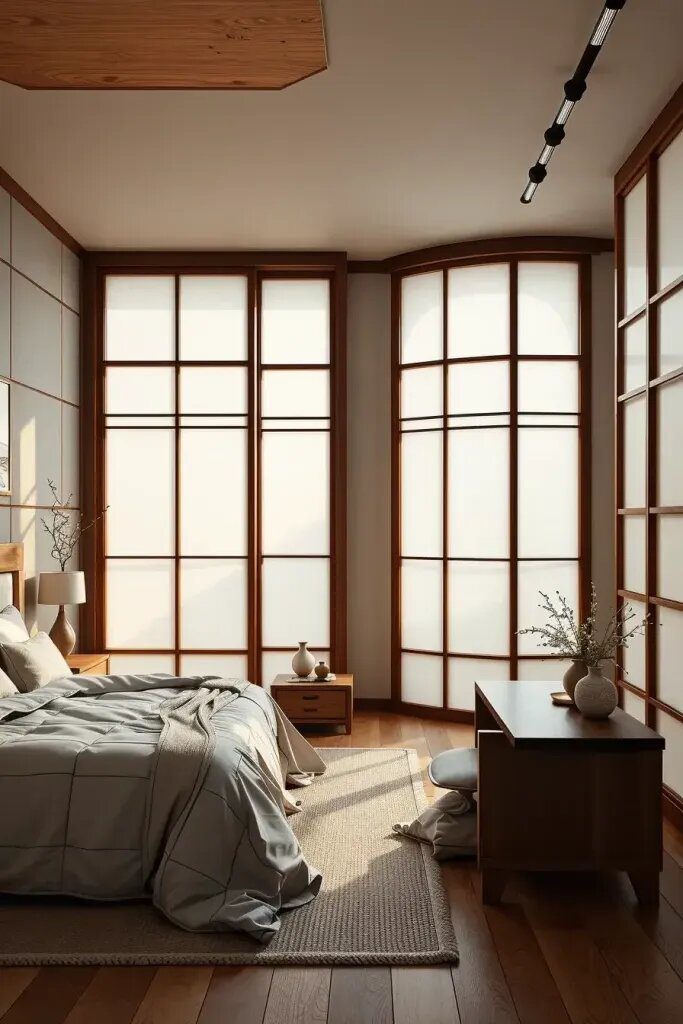
I really like choosing wooden frames with either frosted glass or fabric infill. It’s just lovely how the light shines through and softly lights up the room. Plus, they make it easy for people to come and go without adding clutter to the floor, which is perfect for smaller or city spaces. The panel patterns also help give the room a nice, organized look.

So, I was reading this article in The New York Times the other day, and they were raving about these Shoji panels. Apparently, they’re great for creating a nice, breezy vibe in a room. People say they really help to make a space feel more relaxed and classy. They seem like the perfect addition to a Japandi-style bedroom, don’t you think? It’s like they combine style and functionality seamlessly. Just what you need for a cozy and chic space!
You know what would really take this painting to the next level? Adding some subtle, soft lighting behind or alongside the panels to create a hint of shadows. It would help bring out the shapes and enhance the overall mood of the piece. Just imagine how cool that would look!
When decorating Japandi bedrooms, I like to keep things simple and opt for Scandinavian-inspired artwork. Think of clean lines, subtle landscapes, and muted watercolor paintings that evoke a sense of calm and tranquility. These pieces are more about sparking quiet contemplation rather than demanding attention with bold statements.
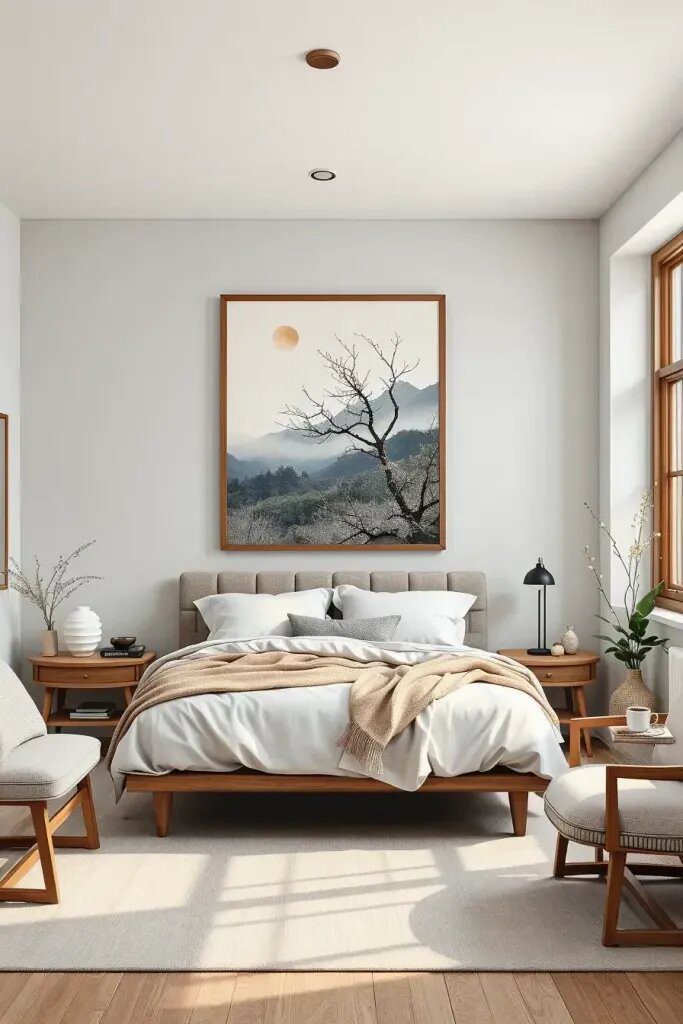
I like to hang my paintings at eye level so that they can be easily admired. I usually only put one or two in frames on each wall, and I prefer wooden or black frames for a classic look. The textured paper, linen mounts, and handmade details add a nice touch of charm. For example, above the bed, a long horizontal piece would look great, or you could put a tall canvas near a cozy reading corner. It’s all about choosing the right position and avoiding cluttered decor. Just keep it simple and let the art speak for itself!
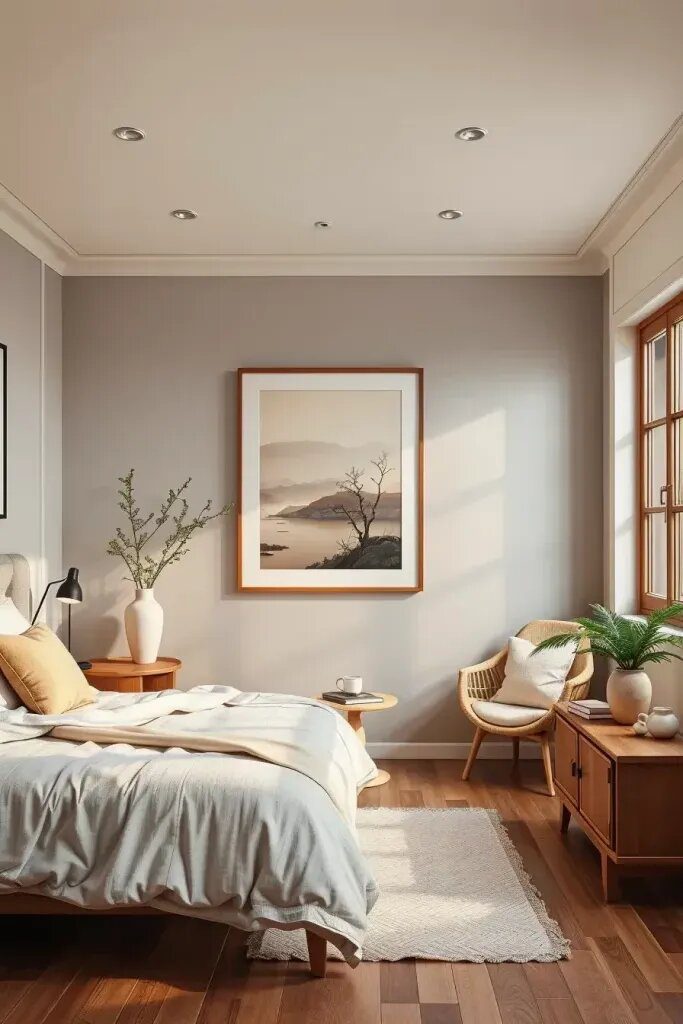
I love finding inspiration in beautiful art pieces by Kristina Krogh and Rebekka Seale. Their work has this calming and down-to-earth vibe that I think would be perfect for a room with Japandi style. The way their designs seem to effortlessly blend in with the space is just so soothing. To me, art should complement the room and create a harmonious atmosphere, rather than stealing all the attention away from everything else.
I think it would be cool to add a little shelf in the corner where we can showcase different items and switch them out easily. It’ll bring some life to the room and fit with the whole Japandi vibe of being flexible and evolving.
Houseplants That Blend With Calm Decor
I’ve noticed that Japandi-style bedrooms usually stay away from using green elements, but I think adding a few houseplants can really liven up the space. Personally, I like to decorate with plants like rubber plants, snake plants, or bonsai because they’re chic and easy to maintain. They bring a nice touch of nature to the room without overwhelming it.

I usually go for simple terracotta or stone pots for my plants, nothing too fancy. I love having a cute little olive tree in a white pot or a hanging pothos around the house. I find that having just a couple of plants in a room is perfect for me. They help break up the space and bring a nice, calming vibe to the garden.

Have you ever thought about adding some plants to your home to help improve your mood and the air quality? Experts like Hilton Carter suggest that having some greenery around can make a space feel more calming and help you sleep better. You don’t need a whole jungle in your Japandi-inspired area; just a touch of nature can make a big difference in how you feel.
Here’s a fun idea to make your pots really pop – why not try putting them on a bamboo stand or a pebble tray? It’ll give them an extra special touch and make them stand out even more!
In Japandi style, we embrace the cozy vibe of an open closet, even though it might seem a bit risky. It actually helps to liven up the room and make it more inviting. Personally, I like to use rack systems with rails or wooden dowel hangers that I mount on the wall. By picking out linens that match or complement each other in color, they seamlessly blend into the room’s overall design. It’s all about creating a harmonious and aesthetically pleasing space!

I like to create open closets with a wooden frame, shelves for stacking sweaters, and a cute little seat underneath for shoes or storage boxes. If you need to hide it, there’s a linen curtain you can pull shut. I always make sure the wood and fabric colors match the rest of the room too!

Deuter was inspired by those cute little Scandinavian studio apartments where everything serves a dual purpose – practical and decorative. When you take care of it, the system looks neat and tidy and is way easier to manage. It’s kind of like what Marie Kondo preaches about decluttering and only keeping things that spark joy. Seeing is believing, right? So having visual support really drives home the idea.
I think a simple backboard made of natural wood or fabric would really spruce up the closet! It not only looks nice, but it also acts as a barrier for the wall. It gives the whole closet a more stylish vibe, instead of looking like it was just thrown together haphazardly. What do you think?
Sleek Floating Nightstands Add Style to Your Bedroom
I love the idea of floating nightstands to help keep your room looking open and spacious! When people ask me for tips on decluttering and maintaining that clean, sleek look in their rooms, I always recommend storing items vertically. It creates a sense of openness and lightness in the design, while still providing easy access to your essentials right next to your bed.

I like to have floating shelves made of sturdy wood in a light oak or ash finish. I prefer ones that can be easily mounted on the wall without showing any brackets. I also like nightstands with soft-close drawers or a small recessed space for storage. They’re not only practical but also add a nice touch to the room decor. Adding soft lighting under the shelf creates a cozy atmosphere in the bedroom, especially in the evenings.

I personally love floating nightstands because they give the room a nice airy feel and don’t make it too cluttered. Designers like Bobby Berk even agree that avoiding bulky furniture next to the bed is a good idea. If you’re into sustainable decor, opting for a reclaimed wood nightstand can add some charm to your room while being eco-friendly.
I think to make this setup look even better, you could try adding a cute ceramic tray or a few neutral books for a little extra style. And how about a dried floral stem in a small vase? It’ll give everything a nice touch without making it feel too cluttered. What do you think?
Seamless Integration Of Workspace In Bedroom
Nowadays, lots of people are working from home, so it’s becoming more useful to have spaces in apartments where you can relax and get work done. I find that placing a desk in a Japandi-style bedroom blends in nicely and just fits the overall vibe of the room. I like to create these cozy corners by using colors and materials that complement the rest of the room.

I love using a floating desk in the same color as my nightstands because it really keeps everything looking nice and cohesive in my room. I like to place it across from a simple rattan or wood chair to create a cozy little work area. Above the desk, I have a soft linen pinboard in beige tones where I can stick notes and important papers. The only things I keep on the desk are a ceramic pen holder and a LED lamp to keep it looking organized and clutter-free.

I think clients really like this style because it helps keep the work area separate from the bedroom, which is nice. I read in Dwell magazine that Japandi’s focus on functionality is a key feature, making it a popular choice for small spaces like studios or apartments where everything is in one room.
You know what would really spruce up that corner? Adding a cute little wall shelf above the desk to showcase a plant or a cool art piece inspired by Japandi. It not only makes the house look nice, but also adds a personal touch that shows off your style. Just a simple way to make the space feel more inviting and cozy, don’t you think?
Add Style with Gentle Curves in Your Decor
When you add some curved decorations to a space that is mostly straight lines, it really helps to make the room feel more cozy and welcoming. I find that using rounded shapes in Japandi bedrooms is a great way to add some interest without overwhelming the space with too much simplicity. For instance, you could try adding a mirror with a curved top or a bedside table with a nice oval shape. It’s all about finding that balance between clean lines and a touch of softness!

I really love using things like arched wall mirrors with wooden frames, ceramic vases that have curves, and a comfy boucle lounge chair. They add a nice sculptural touch without being too flashy. They help balance out the typical square shapes of a bed and windows.

A lot of my clients really love the look of curved decor in their homes. I read in Architectural Digest that using soft lines in our decorating can help create a sense of calm and comfort. I’ve been able to put together a cohesive style in rooms without making them feel cluttered.
You know what would look really nice in the bedroom? How about adding a cozy bench with a low arch underneath the bed? It can have some nice textured fabric to give the room a softer feel and make those colorful accents really pop!
Let Light In: Balance Shadows with Ethereal Sheer Curtains
In a Japandi-style bedroom, having lots of natural light is key. It really brings out the beauty of those neutral colors and organic materials. Choosing some sheer linen curtains in a soft off-white or sandy shade can give your room a lovely glow and create some cool shadows too.

I love how these curtains give us privacy but still let in that nice natural light, you know? I usually go for matte black or brushed bronze rods to hold them up, it just looks so clean and sleek. And if I’m in the mood for a layered look, I’ll hang blackout panels behind the sheers. Oh, and I always make sure to hide those ceiling tracks so nothing messes with the view!
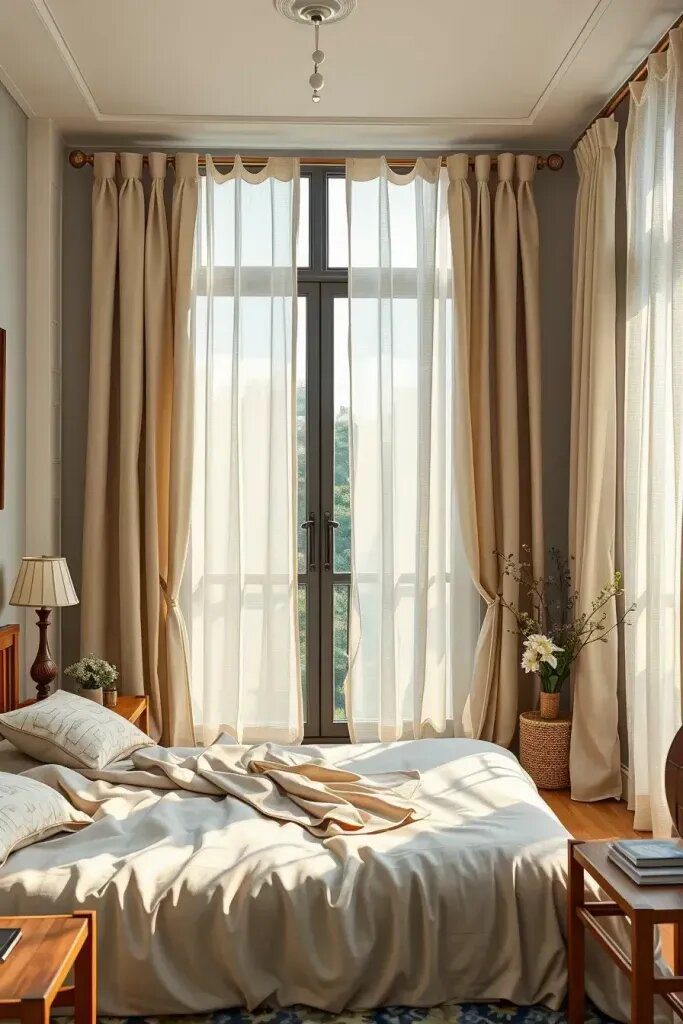
You know, whenever I walk into a room with those beautiful sheer curtains hanging up, it just instantly lifts the vibe, ya know? It’s like they bring a little bit of the outside in, which totally fits with that whole Japandi vibe, all about being connected to nature. Plus, according to the pros at Elle Decor, sheer curtains can help soften up a minimalist space, making it still feel cozy and inviting. Pretty cool, right?
I think a nice touch for this room would be a long curtain with a soft, slightly drooping hem. It would really bring out that cozy, laid-back vibe that comes with Japandi decor, don’t you think?
Designing with intention: Eco-friendly decor for a balanced Japandi style.
So, when it comes to creating a cozy Japandi-style bedroom, sustainability is key. I always like to start by picking out furniture made from responsibly sourced wood, and using eco-friendly materials like hemp, cotton, and linen for that extra touch of warmth and comfort.

I really love using sustainable products in my home! I always go for beds certified by the Forest Stewardship Council, nightstands made from reclaimed wood, and organic wool throws. My go-to accessories are recycled glass vases and natural fiber storage baskets – they really help create a cozy and eco-friendly atmosphere.

So, we decided to publish another version of the same title but with a new text that doesn’t have that strong chemical smell. We also switched to organic bedding, and let me tell you, it made a huge difference in how well we sleep and how the room looks. Better Homes & Gardens even mentioned that making these changes can be good for your health and really elevate the overall design of the room in the long run.
Have you thought about throwing down a sustainably-produced rug like wool or bamboo silk to really tie the room together and stick with the theme? It could be the perfect finishing touch!
Muted Color Blocking For Sophisticated Calm
Did you know you can also incorporate color blocking in a relaxed and easy-going manner? I often use subtle color blocking to divide spaces and create intrigue in Japandi-style bedrooms. For example, you could opt for taupe walls paired with deep stone grey bedding, or add a touch of soft sage green with an accent wall behind the headboard. It’s all about finding a balance and adding a little bit of color to create a soothing and harmonious atmosphere.
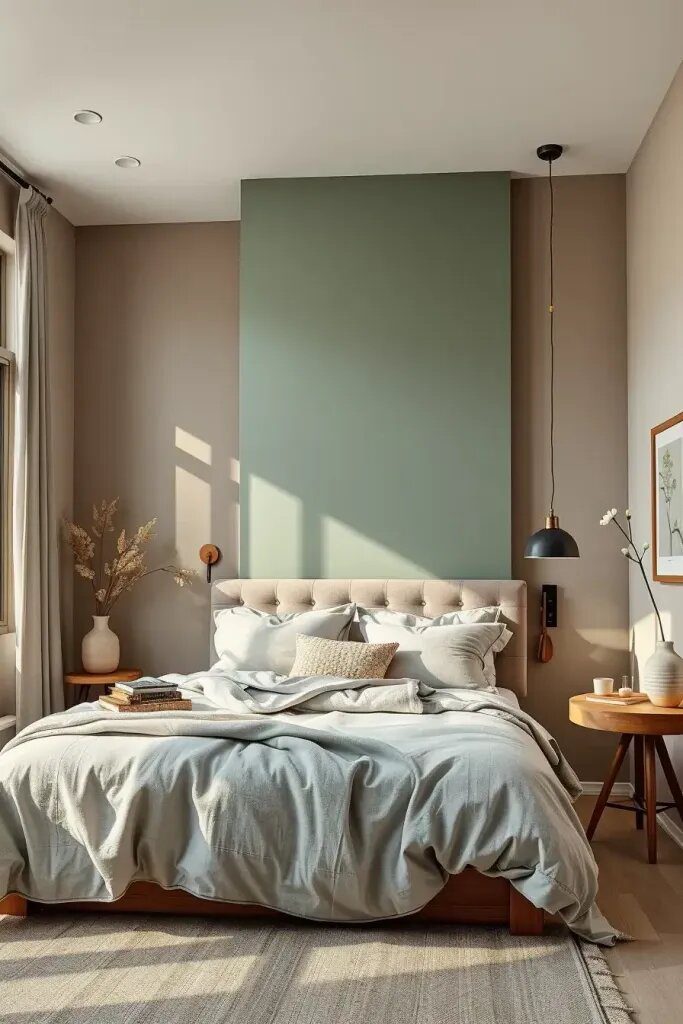
I find that using natural, muted colors like clay, sand, soot, and moss really sets the tone for a peaceful atmosphere in a room. I also like incorporating matte surfaces and textures in my designs to keep things feeling calm. Adding linen bedding and cotton drapes can help soften the colors in the room and prevent any harsh clashes. It’s all about creating a cozy and welcoming space!

Based on my experience, I’ve found that this style really shines when there’s plenty of light to bring out the different tones. I read this interesting article in House Beautiful recently that talked about how incorporating neutrals into your decor can create a calming and relaxing vibe, similar to what you might see in Japanese or Scandinavian design. It’s all about creating a peaceful and harmonious atmosphere in your space.
To really elevate the look, consider adding some wall art or hanging ceramic pieces in colors that match your palette. Just make sure to space them out only a few inches apart for a more cohesive feel.
Artisan-made Ceramics Add Charm to Your Home
You know, I really believe that designing a space that’s not only functional but also pleasing to the eye is totally doable. That’s why I love the idea of using artisan ceramics – they add a unique touch and can be so versatile. I love incorporating handmade ceramic bowls, vases, and lamps in my decor because they’re not only visually appealing but also super practical.

I usually go for matte glazes in colors like charcoal, ochre, and ivory for my nightstand or shelves. They add a nice texture without being too overwhelming. I like to keep my jewelry and daily essentials in wide, shallow ceramic trays for easy access.

You know, having some beautiful ceramic pieces around can make a room really come alive and even catch your clients off guard. I read on Design Milk that artisan ceramics are a key element in modern interior design, especially with that whole Japandi vibe going on. It’s like they just belong together, don’t you think?
Hey there! I suggest adding a ceramic wall sconce or a pendant lamp to your space. Not only will it give you some nice lighting, but it’ll also add a touch of art with a soft glow. Just a little tip!
Cosy Evening Ambiance with Soft Lighting
Lighting is so important in the Japandi bedroom! It really sets the tone for a calming space where you can unwind and stick to your usual routine. I like to break it down into three types of lighting: overhead, bedside, and accent. This way, I can create a cozy and adaptable atmosphere for when it’s nighttime. I always opt for soft bulbs with a warm glow to maintain that comforting vibe, rather than anything too bright and energizing.
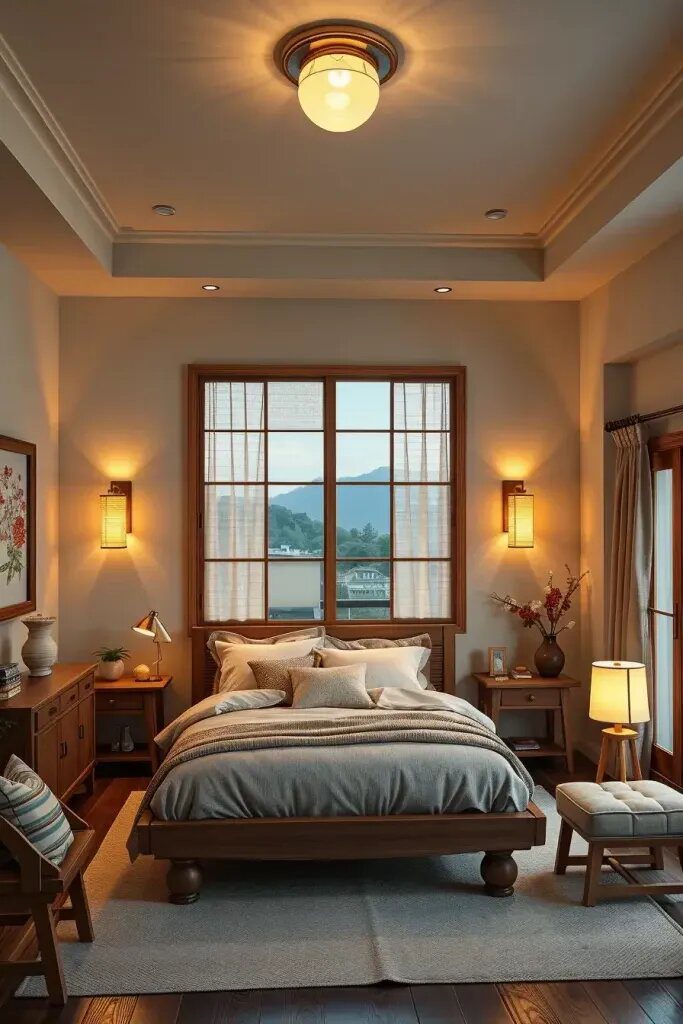
I love setting the mood in a room by using a ceiling light fixture with an adjustable LED. I also like to add some ambient lighting with wall-mounted sconces or paper lantern pendants. To cozy up the space, I always make sure to include a small table lamp with linen shades on each side table. I prefer bulbs that emit a warm, inviting light around 2700K for a relaxing vibe.

I’ve noticed that when you get the lighting just right in a room, it can really make a difference in how the space looks and feels. Having the right kind of lighting can help us relax and get better sleep at night, while also setting a nice mood overall. That’s why I love how Japandi lighting does such a good job of providing that perfect balance of light, especially when you’re trying to unwind at night.
Hey, here’s another suggestion to really bring this design together – why not add a floor lamp made from wood or stone? It’ll really tie the room together and add a nice touch of warmth and texture. Just a thought!
In Japandi homes, it’s common to see soft, neutral colors. But I always suggest throwing in a little bit of black to add some extra style and give the space a bit more definition. Just a touch of black can really make the colors pop and stand out in the room.

I like to incorporate black into my decor through things like lamp bases, curtain rods, drawer pulls, and pictures in black frames. Choosing a headboard with a black soft fabric or dark-stained hardwood is a good way to make the bed blend nicely with the space. Adding a vase or light fixture in matte black ceramic adds some visual interest without making the space feel too cold.

A lot of my clients who want Japandi bedrooms love adding black details because it gives the space a more intentional and architectural look. I read in Domino magazine that using black in small doses shows good restraint and adds a nice touch to the overall interior design.
How about adding a cool black-framed wall mirror or a sleek black console table in front of the window? It could really help emphasize the different textures in the room.
Soft and Cozy Layered Area Rugs in Natural Tones
A lot of designers tend to forget how important comfy flooring can be. I always suggest to my clients to consider using a few area rugs made of natural materials and simple colors. Not only do they add comfort and texture, but they also help reduce echo in the room. Plus, they can help define separate areas in open floor plans or large rooms. It’s a simple way to make a space feel cozy and inviting!
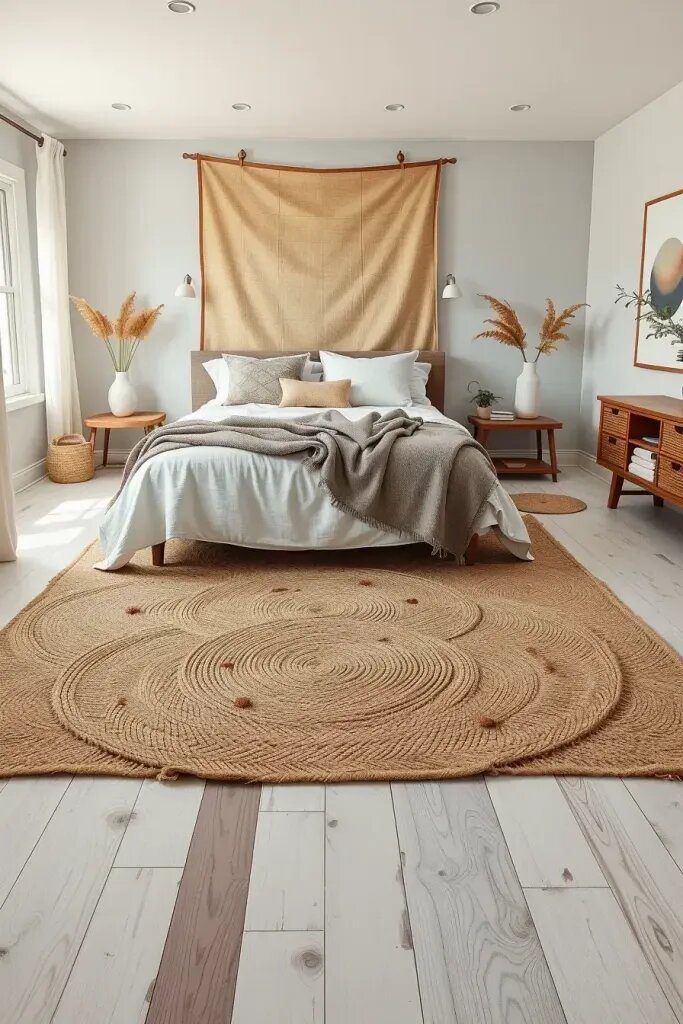
I love using a simple jute or sisal rug as the base for my room, with a cozy wool or cotton rug just under the bed legs. I like to choose patterns that have subtle color variations, like soft grids or slightly curved lines. It’s kind of like the minimalist styles you see in Scandinavian and Japanese decor.

I think it’s really important to use this trick to make sure your bedroom always looks put together and functions well too. A lot of designers at Architectural Digest swear by layering rugs because it not only serves a purpose but also brings more depth to plain rooms.
I think it would be really nice to add a round felt rug next to a cozy reading chair or meditation cushion. It would not only make the space look better but also add some extra comfort and style. What do you think?
Softly Textured Upholstered Headboards
I really love the cozy feel of an upholstered headboard with a Japandi vibe. Whenever I’m choosing one, I always go for materials like linen, cotton, or a wool blend in neutral colors like stone, cream, or light greige. It’s all about achieving that perfect balance of comfort and style without going overboard. What’s your go-to headboard style?

Personally, I like designs that have a panel-led or rounded aesthetic that complements the overall simplicity of the area. The furniture coverings help reduce noise in the room, making it even quieter and more peaceful. Adding linen sheets and a soft neutral quilt brings a calming and cozy touch to the room.

A lot of folks who switch from regular beds really seem to love it the most as their favorite sleep setup. According to Real Simple, having soft furnishings in your bedroom can make the space feel more relaxing, which goes really well with Japandi design.
How about adding a little shelf by the headboard? It would be perfect for keeping things like a candle or drink within reach. Plus, it’ll make the whole design look even better!
Discover 5 Ways to Add Calm to Your Space with Japandi Bookshelves
In the Japandi style, it’s important for your bookshelves to be both practical and good-looking. I like to go for natural wood shelves that are low and easy to reach, with lots of room for books, ceramics, and other special items.

I prefer using oak, ash, or walnut for my wood furnishings and I like to keep them in matte or raw finishes. I usually opt for open shelves instead of doors on storage spaces because it feels more airy and looks nicer to me. On my shelves, I usually have no more than two books, a hand-built vase for decoration, and maybe a woven box. It creates a cozy atmosphere that encourages reflection for everyone.

You know, our clients absolutely love these shelves because they really help to promote a sense of mindfulness. According to Kinfolk, having clutter-free shelves is all about living more in the moment, which is a key principle of Japandi design. A room with lots of open space tends to feel much more relaxing than one filled with lots of things to store.
If there’s one thing I could do to enhance them, I would put a slim LED strip under the shelves for some gentle, night-time lighting.
Furniture Arrangement with a Touch of Balance and Asymmetry
In Japandi bedrooms, we steer clear of having everything perfectly matched up. We like to let balance and interest come together organically. You’ll often see new nightstands, chairs, or lamps placed around the center of the room to keep the space feeling cozy and well-balanced.

I really enjoy putting a bigger nightstand on one side of the bed and a smaller side table or stool on the other. Adding a floor lamp for some extra light is always a nice touch. I also like hanging a picture in a frame slightly off-center above the headboard; it adds a nice touch to the room. It’s important to choose pieces that have meaning to you rather than just randomly picking things out. Everything should have a purpose and fit well together in the design.
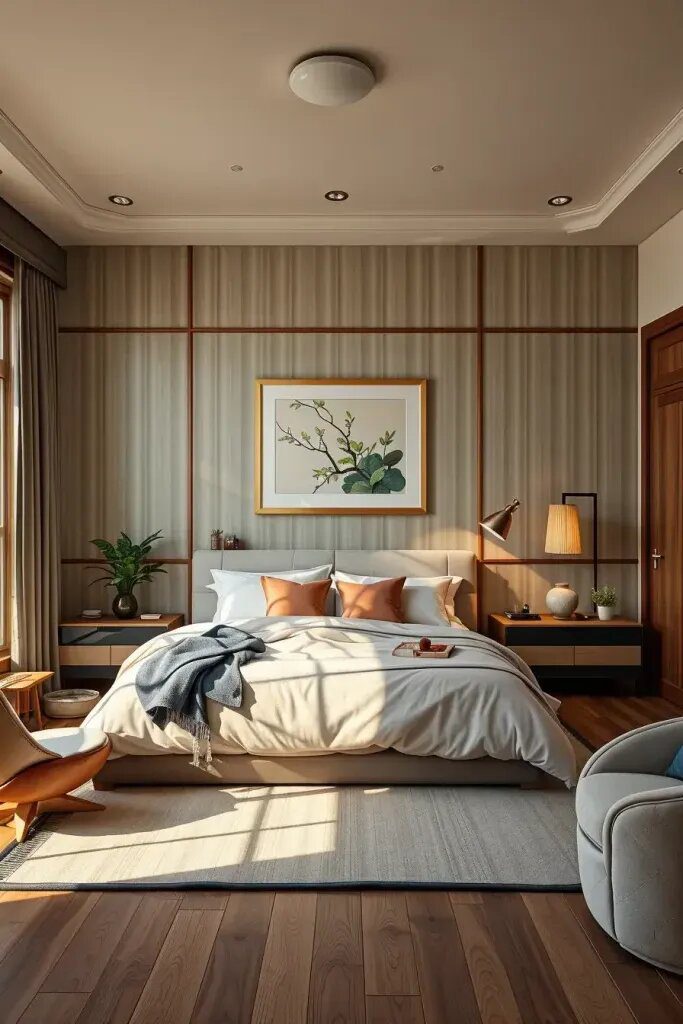
With this approach, your home will have that cozy, lived-in feel while still looking beautifully designed. A lot of Japanese and Scandinavian designers have said that they love celebrating natural imperfections, which is why you don’t see as much symmetry in their unique designs.
One idea could be to place a tall statue or a big indoor tree off to the side by a window to really make this style stand out.
Quality fabrics elevate the simplicity of your style
So, have you heard about this cool design trend called Japandi? It’s all about keeping things simple and cozy in your bedroom, with just a few standout pieces of decor. The key is to go for natural, breathable fabrics that add a touch of elegance to the space. Think Belgian linen curtains, handwoven wool throws, and some soft, earthy percale cotton sheets. It’s all about creating a calm and inviting atmosphere in your room, you know?

I love adding layers to my bed with cozy duvets, coverlets, and accent cushions in soothing colors like sand, oatmeal, or soft charcoal. It really helps make the room feel calm and inviting. I always make sure to choose textures like nubby linens, waffle weaves, or soft bouclé that are not only nice to touch but also have a simple, elegant look.

I think layering different textures and materials can really elevate a room’s look without making it feel too crowded. Apartment Therapy says that true luxury comes from using high-quality materials thoughtfully, not just piling on stuff. Personally, I’ve found that switching to better materials in my designs can actually have a bigger impact on a room’s aesthetic than buying new furniture.
If you want to make your bed even more sturdy and cozy, consider placing a soft fabric bench at the end of it. A classic wool-blend bench can really tie the room together by adding some extra comfort, texture, and harmony.
Show off your Japandi style with stylish wall niches
Have you ever considered adding a wall niche to your Japandi-style bedroom? It really helps create a beautiful and cozy atmosphere. I like to use lamps to subtly highlight my decor without overwhelming the room. By installing a niche above or beside the bed, it not only adds more space but also gives your room a stylish architectural touch. It’s a great way to showcase your decorations without being too in-your-face about it.

In my Japandi bedroom, I like to fill the empty spaces with handcrafted ceramic vases, stacked bowls, or stone statues. I just love how they represent Wabi-sabi, embracing imperfections and the beauty of natural materials. Plus, with the cozy dim lighting in the room, these pieces really stand out and add a special touch. I always make sure to round the edges of the niches to keep everything looking harmonious and balanced. It just adds that extra special touch to the overall design.

I recently added a small niche to my bedroom to give it some extra flair. It was a great way to add some interesting detail without buying new furniture. I read in Elle Decor that covering the inside of the niche with textured plaster can really make it pop, and I totally agree! It adds a cool textured dimension to the room without having to paint it a different color. Plus, it looks awesome with the natural sunlight streaming in.
You could also consider adding some twinkly lights or mix up the depths of your wall nooks. For instance, if you have a long, horizontal nook above your bed, you can really make a statement with it. On the other hand, if you’re working with a space next to a closet, a smaller vertical nook can add both practicality and flair.
Cozy Japandi Bedroom Design Tips for Tiny Rooms
You know, I’ve realized that creating a Japandi-style bedroom in a small space can be really rewarding. It’s all about being mindful and not going overboard. In my small bedroom, I focus on using high storage options and opting for a low bed frame to make the room feel more spacious. I’ve also found that painting the walls in soft beige or warm white really helps to keep that serene Japandi vibe going. It’s all about balance and making the most of what you have!

I usually go for a low, tatami-style bed base or a floating platform because it really opens up the room and makes it feel bigger. It’s also great to have furniture that serves double duty, like a wardrobe with hidden storage or a bench that you can sit on and store things in. I like having wall lights above my bed to save space and keep things organized. And I always go for light wood veneer on my wardrobe to create a peaceful and cohesive vibe in the room.

I love having linen curtains all around my room because they add a cozy touch and make the space feel larger. I read in Architectural Digest that using soft, draping textiles along with natural wood accents can really open up a room, so I tried it out in my own house. It’s amazing how it helped me avoid crowding the space with too many pieces of furniture.
If you notice there’s some space there, why not add a cute little shelf underneath to keep your things organized without blocking the gap? And hanging a paper lantern light above the table will make the room feel cozy and fit with the Japandi style.
Using Beige, Ivory, And Charcoal For Depth
I really love how the colors are picked in Japandi style. The soft tones like beige, ivory, and charcoal work so well together without taking away from the calming feel of Scandinavian design. In my bedroom, I like to keep things simple with ivory walls and add in some beige and charcoal textiles and accents for a nice pop of color. It gives the room a nice balance without overwhelming the senses. It’s all about finding that perfect mix, you know?

So in this one project, I went with a beige linen duvet, a light ivory headboard, and some cozy charcoal wool throw pillows. It was a subtle change, but it really came together nicely. I also added a charcoal-colored rug with a low, natural fiber pile to give the room a grounded feel. And for the furniture, I stuck with oak nightstands, a fabric bench, and some sleek black metal legs on the lights to tie everything together without making it too obvious. It all just flowed nicely without being too busy.
When you’re working with colors in design, a good tip is to follow the 60-30-10 rule. Basically, you give 60% of the focus to your main color, 30% to additional colors, and just 10% to highlights. It’s a trick I swear by! Another suggestion from the magazine is to choose soft colors with similar undertones to keep everything looking harmonious and balanced. Have you tried these tips in your own design projects?
How about using a charcoal or black vase, or even something in slate, to jazz up the color scheme a bit? It’ll really make those darker shades pop! And consider adding a wall tapestry made from natural materials for some texture while still keeping that classic color palette.
Adding personal touches to create a serene atmosphere.
I personally love the Japandi bedroom style because it’s all about creating a peaceful atmosphere. But what really makes a space come alive are the personal touches you add. Whether it’s incorporating old wooden items from your travels or displaying beautiful sketches from friends, these little details can really complement the Japandi design if done right. I often advise my clients to start by setting up a serene foundation and then slowly layer in meaningful pieces. It’s all about creating a space that reflects who you are.

I love adding little touches to my space to make it feel cozy and welcoming. I placed a cute ceramic incense tray on the side table, a favorite photo in a linen frame on the shelf above it, and a well-loved book on the bedside bench. These simple items really add character and warmth to the room. It’s not about cluttering up the minimalist look, but enhancing it. I find that rough or handmade items bring a unique charm that complements the Wabi-sabi feel of Japandi design.

When we talk about Japandi spaces in House Beautiful articles, the designers always suggest picking out items that hold sentimental value, as long as they match the overall aesthetic of the style. This means opting for muted colors, clean lines, and natural materials. I totally agree with this approach. I took their advice and blended minimalist design with my own personal touch.
Hey, here’s a cool idea – why not add a linen wall rail or pinboard in a nice neutral color? You can use hanging pockets to keep things organized. Adding small personal touches like pressed leaves, sketches, or bits of fabric can really make the space feel cozy and inviting. Just a thought!
So, have you heard of the Japandi-style bedroom? It’s all about creating a space that’s relaxing, simple, and has a bit of character to it. Whether you’re dealing with a small room, playing around with different colors, or adding personal touches, each aspect helps create a cozy hideaway. If you have any helpful tips or if you’ve come up with your own unique ideas for designing in the Japandi style, I’d love to hear all about it!

